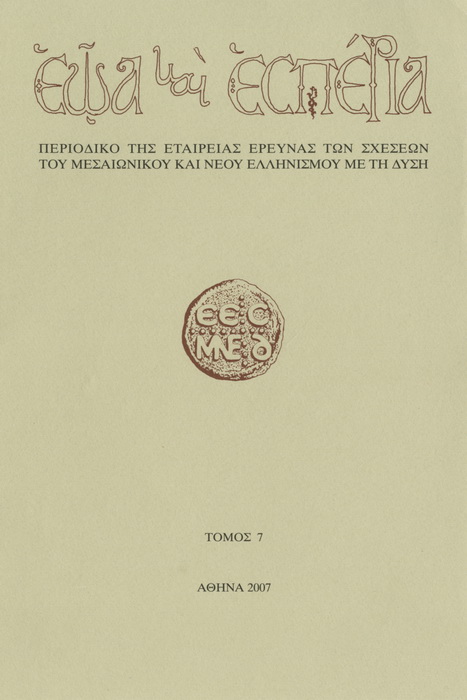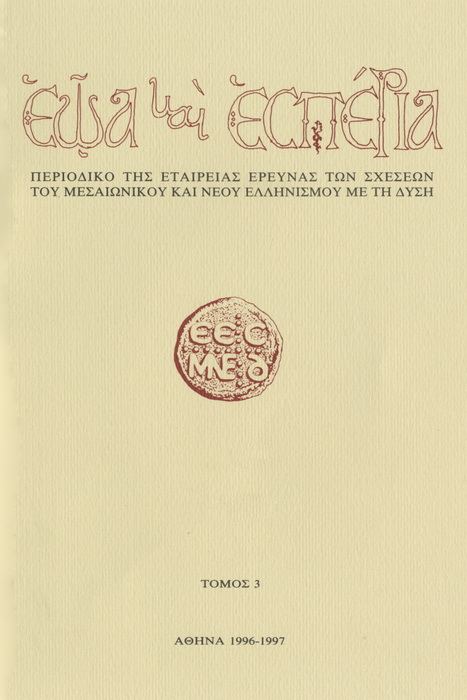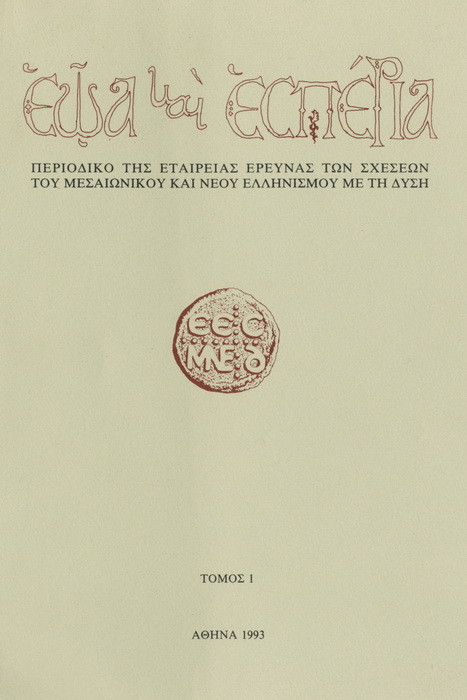ΕΛΛΗΝΙΚΕΣ ΚΟΙΝΟΤΗΤΕΣ ΚΑΙ ΕΥΡΩΠΑΪΚΟΣ ΚΟΣΜΟΣ (130Σ-190Σ ΑΙ.). ΜΟΡΦΕΣ ΑΥΤΟΔΙΟΙΚΗΣΗΣ, ΚΟΙΝΩΝΙΚΗ ΟΡΓΑΝΩΣΗ, ΣΥΓΚΡΟΤΗΣΗ ΤΑΥΤΟΤΗΤΩΝ»: ΜΙΑ ΕΡΕΥΝΗΤΙΚΗ ΠΡΟΤΑΣΗ
Περίληψη
This paper provides an overview of the above research programme, whichwas implemented as part of the PYTHAGORAS II programme administeredby the EU in collaboration with the Hellenic Ministry of Education andReligious Matters and the University of Athens. Professors Olga Katsiardi-Hering and Anastasia Papadia-Lala and Assistant Professor Maria Efthymiou,members of the Department of History and Archaeology, undertook academicresponsibility for the project. The research team consisted of Ph.D. holders andcandidates and post-graduate students (Vassiliki Seirinidou and KaterinaKonstantinidou, as well as Dimitrios Kontogeorgis, Marina Koumanoudi,Sotiris Koutmanis, Ikaros Mantouvalos, Katerina Mousadakou, ChristinaPapacosta, Lambros Travlos), with the contribution of Professor ChryssaMaltezou, Director of the Hellenic Institute of Byzantine and Post-ByzantineStudies of Venice, and Professor Olga Cicanci (Archival Studies at Bucharest).
The historical category of the community as a factor in the history of NewHellenism lies at the heart of the research, which explored various aspects ofthe phenomenon through an examination of numerous urban communities inGreek lands under Venetian rule (13th-18th centuries) on the one hand, and ofthe communities of the Diaspora on the other: the Greek Brotherhood ofVenice, Greek communities and commercial companies in the HabsburgMonarchy, Greek communities in the Trans-Danubian Principalities/ Romania.The two types of community are linked by their connection with Europe, theirsecularity and by their contribution to the emergence of the identity of theGreek populations in a complex politico-cultural environment. The moststudiedcommunity in the Ottoman Empire is used for purely comparativepurposes.
The main research axes were: a) the institutional framework of communityorganization, b) intra-community features, c) community activities.
The research was undertaken in Athens and various sites abroad and wasbacked up by archive material both published and unpublished (embassies,statutes, registers of marriages and baptisms, property registers, wills,commercial correspondence).
The results of the research include:
l.The compiling of academic reports detailing the research results;
2. Electronic processing (a. digital catalogues of archive material, b)electronic publications of transcribed archive material, c) electronic databases,now held at the University of Athens);
3. Academic papers presented at the One-day Conference held at theUniversity of Athens Historical Archive on February 27,2006;
4. The production of academic papers published in reputable academicseries and academic journals.
The historical material assembled and the conclusions drawn from thesubsequent research will contribute to the furtherance of academic researchand teaching at the university level.
Λεπτομέρειες άρθρου
- Πώς να δημιουργήσετε Αναφορές
-
ΠΑΠΑΔΙΑ-ΛΑΛΑ Α. (2007). ΕΛΛΗΝΙΚΕΣ ΚΟΙΝΟΤΗΤΕΣ ΚΑΙ ΕΥΡΩΠΑΪΚΟΣ ΚΟΣΜΟΣ (130Σ-190Σ ΑΙ.). ΜΟΡΦΕΣ ΑΥΤΟΔΙΟΙΚΗΣΗΣ, ΚΟΙΝΩΝΙΚΗ ΟΡΓΑΝΩΣΗ, ΣΥΓΚΡΟΤΗΣΗ ΤΑΥΤΟΤΗΤΩΝ»: ΜΙΑ ΕΡΕΥΝΗΤΙΚΗ ΠΡΟΤΑΣΗ. Ἑῶα καὶ Ἑσπέρια, 7, 139–148. https://doi.org/10.12681/eoaesperia.85
- Τεύχος
- Τόμ. 7 (2007)
- Ενότητα
- GREEK COMMUNITIES AND EUROPEAN WORLD (13TH-19TH C.). PATTERNS OF SELF-ADMINISTRATION, SOCIAL ORGANIZATION, IDENTITIES
Οι συγγραφείς των άρθρων που δημοσιεύονται στα Ἑῷα καὶ Ἑσπέρια διατηρούν τα δικαιώματα πνευματικής ιδιοκτησίας επί των άρθρων τους, δίνοντας στο περιοδικό το δικαίωμα της πρώτης δημοσίευσης. Άρθρα που δημοσιεύονται στα Ἑῷα καὶ Ἑσπέρια μπορούν να χρησιμοποιούνται ελεύθερα, χωρίς δικαίωμα τροποποίησης (δημιουργία παράγωγου έργου) με αναφορά στον/στη συγγραφέα και στην πρώτη δημοσίευση για μη κερδοσκοπικούς σκοπούς. Η Εταιρεία Έρευνας των Σχέσεων του Μεσαιωνικού και Νέου Ελληνισμού με τη Δύση διατηρεί το δικαίωμα να δημοσιεύει, να αναπαραγάγει, να παρουσιάζει στο κοινό, να διανέμει και χρησιμοποιεί άρθρα που δημοσιεύονται στα Ἑῷα καὶ Ἑσπέρια σε οποιοδήποτε μέσο και μορφή είτε μεμονωμένα είτε ως μέρη συλλογικών έργων, για όλο τον χρόνο διάρκειας προστασίας της πνευματικής ιδιοκτησίας και για όλες τις χώρες του κόσμου. Αυτό περιλαμβάνει ενδεικτικά και όχι αποκλειστικά το δικαίωμα δημοσίευσης των άρθρων σε τεύχη του περιοδικού Ἑῷα καὶ Ἑσπέρια, αναπαραγωγής και διανομής μεμονωμένων αντιγράφων των άρθρων, αναπαραγωγής ολόκληρων των άρθρων σε άλλη έκδοση της Εταιρείας Έρευνας των Σχέσεων του Μεσαιωνικού και Νέου Ελληνισμού με τη Δύση, καθώς και αναπαραγωγής και διανομής των άρθρων ή περίληψης αυτών με χρήση πληροφορικού συστήματος αποθετηρίου.





